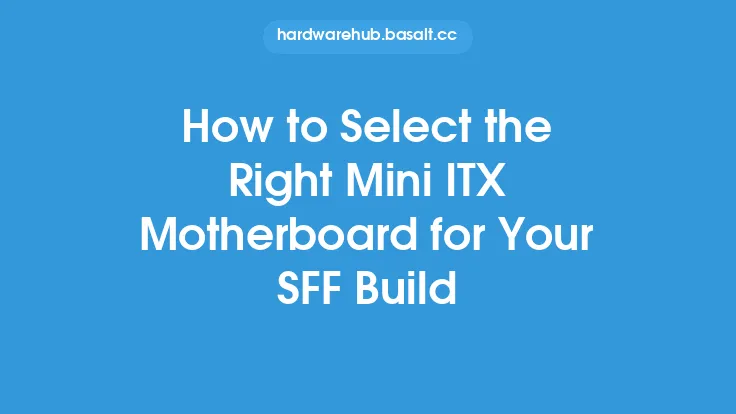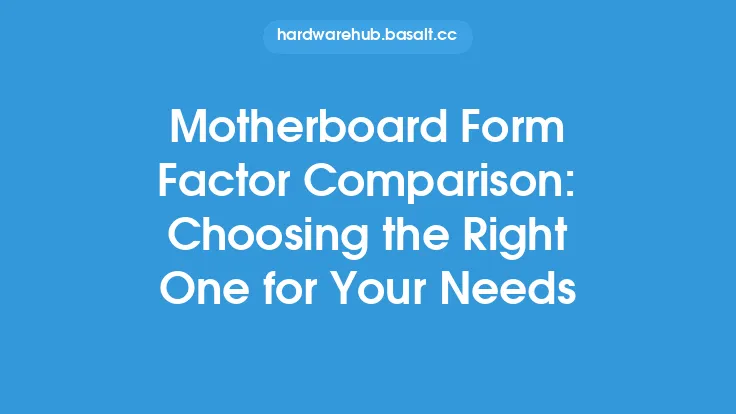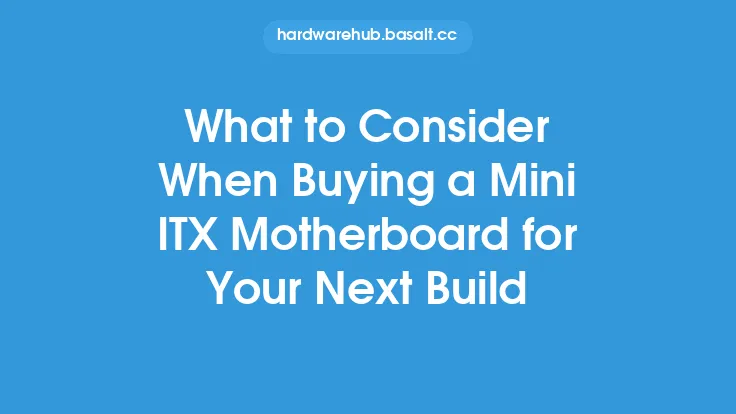When it comes to building a compact computer system, one of the most critical components to consider is the motherboard. Mini ITX motherboards, in particular, have gained popularity in recent years due to their small form factor and versatility. With so many options available in the market, choosing the best mini ITX motherboard for your needs can be a daunting task. In this article, we will delve into the key factors to consider when selecting a mini ITX motherboard, exploring the various features, specifications, and technologies that will help you make an informed decision.
Introduction to Mini ITX Motherboards
Mini ITX motherboards are designed to be compact, measuring 6.7 inches (17 cm) square, making them ideal for small form factor (SFF) builds. Despite their small size, these motherboards pack a punch, offering a range of features and specifications that cater to various needs and applications. From basic office work to gaming and content creation, mini ITX motherboards can handle a wide range of tasks. When choosing a mini ITX motherboard, it's essential to consider the type of build you're planning, the components you'll be using, and the features you require.
CPU and Chipset Compatibility
One of the most critical factors to consider when selecting a mini ITX motherboard is CPU and chipset compatibility. Mini ITX motherboards support a range of CPUs, including Intel Core series and AMD Ryzen series. It's essential to ensure that the motherboard you choose is compatible with your preferred CPU. Additionally, the chipset plays a crucial role in determining the features and specifications of the motherboard. Popular chipsets for mini ITX motherboards include Intel's Z390, B360, and H310, as well as AMD's X470 and B450. When choosing a motherboard, consider the CPU and chipset combination that best suits your needs.
Memory and Storage Options
Memory and storage are critical components of any computer system. Mini ITX motherboards typically support dual-channel DDR4 memory, with some high-end models offering quad-channel support. When selecting a motherboard, consider the amount of memory you require, as well as the speed and latency. In terms of storage, mini ITX motherboards often feature multiple SATA ports, as well as support for M.2 NVMe SSDs. If you plan to use a high-speed SSD, ensure that the motherboard you choose has an M.2 slot that supports NVMe.
Expansion and Connectivity Options
Expansion and connectivity options are essential considerations when choosing a mini ITX motherboard. These motherboards often feature a range of ports, including USB 3.2 Gen 2, USB 3.2 Gen 1, and USB 2.0, as well as HDMI, DisplayPort, and Ethernet. If you plan to use a graphics card, ensure that the motherboard you choose has a PCIe x16 slot. Additionally, consider the number of SATA ports, as well as support for Wi-Fi and Bluetooth. Some mini ITX motherboards also feature high-end audio capacitors and support for high-quality audio output.
Power Delivery and Cooling
Power delivery and cooling are critical components of any computer system. Mini ITX motherboards often feature a range of power phases, including 4-phase, 6-phase, and 8-phase designs. When selecting a motherboard, consider the power requirements of your components, as well as the efficiency of the power delivery system. In terms of cooling, mini ITX motherboards often feature a range of fan headers, as well as support for liquid cooling systems. If you plan to overclock your system, ensure that the motherboard you choose has a robust power delivery system and adequate cooling options.
Form Factor and Case Compatibility
When choosing a mini ITX motherboard, it's essential to consider the form factor and case compatibility. Mini ITX motherboards are designed to fit into small form factor cases, but it's crucial to ensure that the motherboard you choose is compatible with your preferred case. Consider the mounting holes, as well as the location of the ports and connectors. Some mini ITX motherboards also feature a range of case accessories, including RGB lighting and fan controllers.
Overclocking and Tuning Options
Overclocking and tuning options are essential considerations for enthusiasts and gamers. Mini ITX motherboards often feature a range of overclocking options, including CPU multiplier adjustment, voltage control, and memory timing adjustment. When selecting a motherboard, consider the level of overclocking support, as well as the quality of the tuning options. Some high-end mini ITX motherboards also feature advanced overclocking tools, including automatic overclocking and voltage regulation.
Conclusion
Choosing the best mini ITX motherboard for your needs requires careful consideration of a range of factors, including CPU and chipset compatibility, memory and storage options, expansion and connectivity options, power delivery and cooling, form factor and case compatibility, and overclocking and tuning options. By understanding these key factors and considering your specific needs and requirements, you can select a mini ITX motherboard that provides the perfect balance of performance, features, and value. Whether you're building a compact office PC or a high-performance gaming system, a well-chosen mini ITX motherboard can help you achieve your goals and provide a reliable and efficient computing experience.





